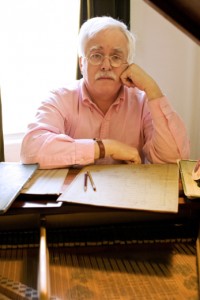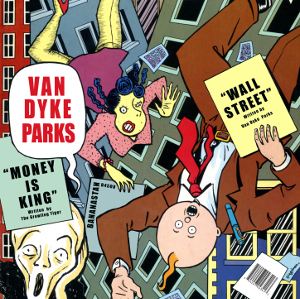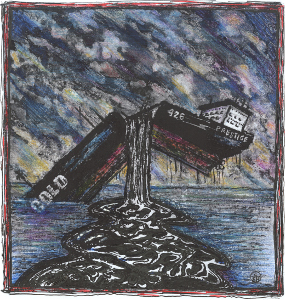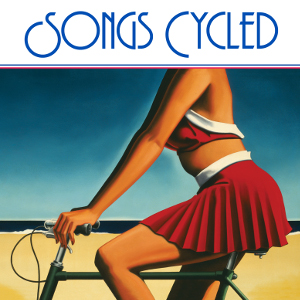ICONS: Van Dyke Parks – On Studio Artistry and “Songs Cycled”
How do you live ten lifetimes in one? You emerge into the world as Van Dyke Parks.

Van Dkye Parks released his seventh studio album, “Songs Cycled”, in the US on July 23rd. (photo credit: Roman Cho)
A deep breath is needed before delving into the bio of this American music master, a composer/producer/arranger/instrumentalist/singer-songwriter/author/actor all in one. Starting as a clarinetist just four years removed from his 1943 birth in Hattiesburg, Mississippi, Parks has proven uniquely unafraid to take risks with his music or career in the ensuing decades.
Blessed with an unmatched combination of lyrical and instrumental prowess – as well as the rare ability to understand music as a continuum – Parks’ imprint stretches across a hallowed hall of collaborators: Brian Wilson and the Beach Boys’ legendary Smile project, The Byrds, Haruomi Hosono, Harry Nilsson, Randy Newman, Ry Cooder, Grizzly Bear, Frank Zappa, and Ringo Starr, among many others.
In his landmark album and film work, he has proven an equally effective revolutionary and counter-revolutionary. Now 70 years young and based out of the sub-LA paradise of Pasadena, CA, Parks has just made an essential new addition to his personal discography: Songs Cycled, his seventh studio album. Startlingly inventive and deeply traditional all at once, the songs there form an exhilarating collection for all aficionados of pure American songcraft.
The newly launched Songs Cycled (a sly full-crcle connection to his 1968 debut record, Song Cycle) gathers together a series of 7” singles that Parks released recently on his personal Bananastan label. The songs were mostly recorded from 2011-2012, with one entry, “Black Gold”, originating from 2002, while the song “Aquarium” dates back to 1971, a hypnotic (and newly mixed) recording of the Esso Trinidad Steel Band performing their steelpan instrumental version of a Camille Saint-Saëns composition.
Part of Parks’ fascinating history has been an on-again, off-again love affair with recording itself. An expert at using the studio as an instrument, Parks was heavily influenced by the inspired workflows of audio/music pioneers including Spike Jones, Les Paul, and Esquivel. Songs Cycled itself is very much an LA product, with Ira Ingber at Muscletone Village Studio, Doug Lacy at Legacy Studios, and Bil Lane and Rich Tosi at Jackson Browne’s Groove Masters Studios, among others in the album credits.
There are 12 aural adventures on Songs Cycled, constructed with violins, cellos, musette, ukuleles, accordion, percussion, guitars, mandola, woodwinds, mandocello, steelpan, acoustic guitar, saxophone, choir, and concertmasters. Centering it all is Parks’ unmistakable folk virtuoso vocals, delivering organically interlocking lyrics that entrance as they unfold. Packed end-to-end with fascinating baroque pop and Americana arrangements, Songs Cycled is an opportunity to reinvigorate the ears and mind at the same time.
So too is speaking with Van Dyke Parks himself, who shares his experiences with the same vibrant energy that drives his music. Read on for his insights on Songs Cycled, his first original album since 1995’s Orange Crate Art – and, as Parks has hinted, possibly his last.
Van Dyke, how does a songwriter such as yourself use the “studio as an instrument?” What does that mean to you?
Well, I started in the world of three-track. Once when I was recording singles at MGM Records in the 1964, for example, three tunes might need to be recorded in three hours. Everything was slap-dash, down and dirty sight reading – very fast stuff. Things had to happen very quickly.
By 1967, I think we were seeing the advent of four-track machines. We used that 3M tape, and working in the 7.5 or 15 IPS world really required a lot of immediate decisions regarding things like application of echo, and microphone selection. Microphones would be moved to form ambient room realities, sectional overheads, to close-ranged targeted tracking.
You worked with one of the earliest home recordists as well in Brian Wilson. How did that inform you?
Brian Wilson had the first eight track machine that I saw in a private home. So basically that was confirming all that I would suspect would happen: That was my introduction to the potential of close range miking, and the number of multiple images on certain tracks. Brian Wilson showed me how that could be a great enabler to an ultimate mix.
Can you give some specific examples of that?
Like whether or not to put the bass pedals of a Hammond organ on a track with a bass, and so forth. The potential for discrete sound groupings expanded exponentially when I was attending the golden age of audio.
The isolation of sound had been addressed before, in the genius of Les Paul. In 1953, Les Paul arrives and he does those magical things with the guitar. And those things could only be attributed to the fact that he had an 8-track recorder — he did it, and didn’t talk to nobody about it. He did it without knowing it could have been an enormous hazard to the public health, which it is in the hands of a fool such as as I. Or of great social value, in the intricacy and the beauty of recorded music.
(Orchestral experimentalists) Esquivel and Bob Thompson’s http://www.sundazed.com/shop/product_info.php?products_id=1160 arranging came into play for me as well. I remember when I first heard the phenomenon of what I call “the phantom,” when the phantom would go from left to right on the stereo at home. Stereo had revealed itself to me when the ‘60’s arrived, and I knew it was a brand new ballgame. Hi-Fi stereo, wow. I became a part of that world and I pursued it.
Starting up Songs Cycled
What made this the right time to release your newer recordings together as Songs Cycled?
Songs Cycled is an entirely new event in terms of mixes. All of these are new mixes, some of them songs that I had been working on for over five years, but I didn’t finally master until a year and change ago. I brought them back in a staggered form to release, them, and my intention was to come up with 12 new selections that could be put on a record.
A long-playing vinyl record is what I wanted. I wanted something that could be held, and reminded me of when I came into recording, which was the world of vinyl.
Is there a way to characterize the way you recorded the tracks on Songs Cycled?

Satire and sarcasm, thy name is “Money is King”, one of the captivating tracks on Park’s new album. (Artistic credit: Art Spiegelman)
The songs all are different in a way. It’s safe to say the music is multi-faceted and trans-generic. I have no problem with that, that’s just who I am. I’ve had a great time doing it, and I believe in the work.
Each song had a different recording approach. Some required a room full of strings, as in “The Parting Hand”, and were done in my living room. I would bring a vocalist, cellist, and bassist in, and I would record them separately in my house. I can’t tell you the name of the microphone, but I can tell you it was expensive.
When real estate came into play, I would go into a room that was wood paneled. For “Amazing Graces,” that sounded fantastic. That was at Western Studios.
“Hold Back Time” I remember was done at Groovemasters recording studio, as was “Money is King.” Groovemasters is Jackson Browne’s studio, and it’s a very fine studio, because it combines the best of both worlds. I use analog, but I’ll use the fundamentals of a computer-devised sequence. I straddle the age of MIDI and the nitty gritty of analog live performance.
Sometimes when things get grey, I’ll just use live performance. I used Doug Lacy’s studio, http://www.allmusic.com/artist/doug-lacy-mn0000539431 studio because I love the piano. I love that Mason & Hamlin piano — he’s a technician, and it’s a precious piano.
And I also like the dimensions of Jackson Browne’s studio, Groovemasters. I like the fact that it has such a pantheon of outboard tube stuff to hold up the warmth of the sound, and also sometimes to forgive what I call digitalis – that final digital reality.
“Aquarium” is a piece from beyond that period (recorded in 1971). To me, it’s the best recording of a steel band that you’ll ever hear. It was recorded in the front room of Sunset Sound. That was beautifully done, engineered by Doug Botnick, really fine work – I can’t tell you exactly how many mics were in the recording for this 28-man group called the Esso Trinidad Steel Band, but it was a lot of mics.
And the fastidiousness of that sound. There was an engineer, Doug Botnick – he put the hyphen in between anal and retentive. Are you still there?
Yes, of course!
Well, you’re very kind.
The Intermittent Audio Engineer
How would you say your own relationship with audio engineering has evolved throughout your career?
At one time I was one of four guys in LA with a synthesizer. It was a big deal. I knew every microphone available for our enjoyment. I was filled with information.
Then I watched the technocrats lunge ahead. Some musicians would get trucking companies. And as time wore on I became more interested in writing notes than taking notes. That’s when I started finding delicate strength in people like Doug Botnick or his brother Bruce. So I came in (to this record), I’m ashamed to say, as a layman, with general terms lacking the specifics of recordings.
But a big moment in my life recently was recently on Record Store Day when Warner’s printed a remastered mono version of Song Cycle. I said, “Why are they doing it in mono? Who’s going to give a damn?” But hearing that noise, that was home plate for me. It was my briar patch. It was where I wanted to be. I think this record shows I have learned from that world, and want to return to it.
Why do you think it’s important for analog delivery formats, like vinyl, to remain viable?
Because there are a lot of kids today who have ears, who will realize the inferiority of digital sound to vinyl reproduction.
It is an inconvenience to have physical specimens of your work, when audio can be downloaded – by the way for a fraction of a cent to the creators – but what is being lost is really significant: What it is, is music is becoming more monastic. More people are working in closets in digital production and reproduction, and we’re hearing the dismal results.
Less attention to arranging, less support for artists and recording musicians – when’s the last time you saw the name of a bass trombonist credited on a record jacket? But there’s a lot of musicians out there.
My life is now spent partly bridging the world of analog and the digital reality. So both the analog reality and the digital reality are represented in this album I just came out with. Yeah, I haven’t given up.

“Black Gold” as captivating as it is chilling, is a prime example of Parks’ extreme gift for lyrics and storytelling. (Artistic credit: Frank Holmes)
“Black Gold,” which recounts the tale of the disastrous 2002 Prestige oil spill, is possibly one of the most sobering songs every recorded. The recordings of the background singers are what grabbed me the most — can you tell me about orchestrating and recording them, as well as other aspects of that song where you applied studio techniques?
Let us credit (engineer/mixer) Ira Ingber, and the singer Kathy Dalton. She has an almost Bambi-esque soprano quality – it’s so soprano, you might think it were built for icing in a bakery. She has that edge-of-a-knife kind of thing. And to tell you the truth, I’m very exacting – I work hard at EQing the background voices, to give them a chance to participate.
Rule One for me in recording is “all things apparently equal.” Whatever is going on, should be equally evident. There can be exceptions to that – in “Black Gold”, it’s the five cellos: They are mellifluous, mellow as a cello. So I do what I can to make the experience very listenable, very entertaining, but with a lot of post-recording attention to detail, like positioning and EQ.
Your new recording of musician/painter/playwright Billy Edd Wheeler’s 1961 classic “Sassafras” also is an attention-grabber – it’s a classic song updated with modern studio techniques.
There is something to Appalachia, the redneck proletarian quality, the hopeless endeavor, comes through so well in Billy Edd Wheeler. Everyone’s asking, “What’s new?” What’s old is all that’s new about me. So what I did with an old song, “Sassafras”, is a way of reconfiguring the past with tempestuous activity.
Recorded music is different from performed music. “Sassafrass” fulfills my love for recorded music. It’s as if I were revisiting the studio’s potential, as with Spike Jones in “Cocktails for Two”. When I heard Spike Jones, I realized that recorded music is different from performed music.
My life has been devoted to what recorded music can be. I’ve done that at the service of other people who have had the authority to decide where that would take us: Brian Wilson, Randy Newman, Natalie Cole, U2 – so many people I’ve observed who have had their ideas.
It sounds like you’re still enjoying the recording and mixing process.
I’m having so much fun in the studio. I think it’s safe to say I’m a veteran of the exploration of recorded music. I am still baffled by it, and waiting to test its very limits.
— David Weiss
Please note: When you buy products through links on this page, we may earn an affiliate commission.








randolphr
August 2, 2013 at 12:59 am (11 years ago)I am Always interested in what Van Dyke has to say …. Thank you both !
Marc Alan Goodman
August 2, 2013 at 6:47 am (11 years ago)Dave – Great interview with one of my all time favorites. Thanks!